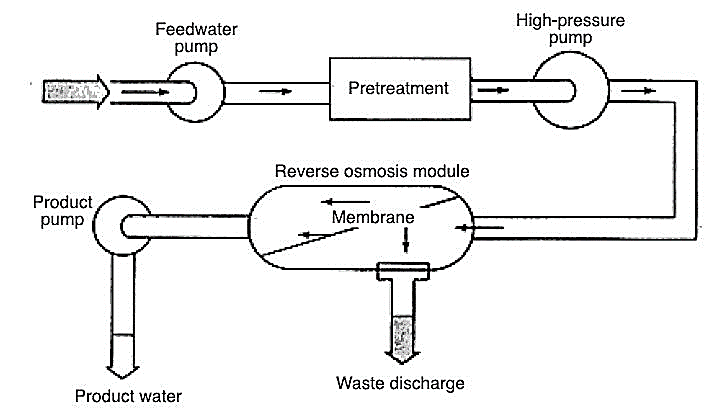
Seawater Desalination with Reverse Osmosis Plant
All Reverse Osmosis plants are in essence Desalination Plants but desalination is becoming referred to sea water Generally.As sea water has really significant TDS necessitates incredibly higher force to drive sea water by means of membranes which happen to be diverse then brackish h2o membranes.
Reverse Osmosis Plant Facts:
A reverse osmosis plant is a manufacturing plant, exactly where water is purified and desalinated by forcing water through a membrane, usually generally known as a reverse osmosis course of action. Drinking water produced by plant RO could possibly be employed for various uses like desalination, wastewater cure, and the reclamation of dissolved minerals.
RO Plant Description
A mean consuming drinking water RO plant program needs six KW several hours of electrical energy to desalinate just one cubic meter of h2o. Reverse osmosis water plants involves a number of pre-treatment approaches like softening, DE chlorination, and anti-scale remedy. Following pre-treatment, significant amounts of stress send h2o through a semi-permeable membrane, which retains all contaminants besides h2o.
RO Plant Style and design
To boost the performance and life of the Reverse Osmosis plant, helpful pretreatment on the feed water is needed. Choice of the ideal pretreatment will increase performance and membrane existence by lessening:
Fouling
Scaling
Membrane Degradation
RO plant layout is consisting of:
Determining pretreatment necessity of Reverse Osmosis Plant
Should the feed drinking water has traces of large metals, it is highly recommended to dose some chlorine to alter the dissolved heavy metals to Bodily form, the media filter will filter most of it inside of a ro drinking water purifier plant.
Reverse Osmosis Plant Array of membrane
Membrane aspects are a very important Element of RO crops. The proteins (generally polyamide) that makeup membrane aspects fluctuate according to the ending clarity and intake h2o seawater or brackish water and so on
Waterman engineers Australia RO plant for seawater desalination
Waterman Engineers in Australia has built a Reverse Osmosis (RO) plant for seawater desalination, which offers a number of advantages about other desalination procedures. Below are a few essential great things about their RO plant:
Power Effectiveness:
Compared to other desalination methods like thermal distillation, RO necessitates much less Electricity. Waterman Engineers' RO plant makes use of Innovative membrane technological innovation, allowing it to operate at reduce pressures and lower All round Power use.
Environmental Impression:
RO generates much less brine discharge when compared with thermal procedures, minimizing the influence on maritime ecosystems. This aligns with Australia's focus on environmental sustainability and conservation.
Significant Drinking water Purity:
The RO procedure effectively removes salts, minerals, and impurities, developing significant-high quality freshwater that fulfills stringent drinking h2o criteria. This trustworthiness is important for offering Safe and sound and clean drinking water to communities.
Modular Style and design:
Waterman Engineers' RO plant employs a modular design and style, allowing for scalability and adaptability. This is particularly beneficial for locations with various drinking water calls for, as modules may be added or modified appropriately.
Lessened Footprint:
RO crops generally have a more compact Actual physical footprint in comparison with thermal desalination vegetation, which often demand substantial infrastructure for heating and cooling processes.
Fast Commence-Up and Shutdown:
RO vegetation can be begun and stopped fairly speedily, allowing for better responsiveness to altering water demands and emergencies.
Lower Chemical Utilization:
Contrary to Several other desalination methods, RO necessitates fewer chemical substances for operation and cleansing, reducing chemical-relevant environmental worries.
Consistency in Efficiency:
The RO method is significantly less sensitive to feedwater quality fluctuations than other solutions, guaranteeing a more consistent performance eventually.
Charge-Efficiency:
Although initial financial investment expenditures could be significant, RO vegetation tend to obtain decrease operational and maintenance expenditures Over time compared to thermal procedures.
Reverse Osmosis (RO) is actually a h2o purification procedure that takes advantage of a partially permeable membrane to get rid of ions, unwelcome molecules, and larger particles from consuming h2o. By applying strain to beat osmotic pressure, it lets the passage of h2o molecules whilst rejecting contaminants, therefore developing thoroughly clean drinking water on a person side in the membrane and concentrated impurities on the opposite.
The working principle of a Reverse Osmosis (RO) plant includes implementing tension to a saline Remedy to pressure drinking water molecules by way of a semi-permeable membrane. This membrane will allow only h2o to go while rejecting salts, contaminants, and impurities, resulting in purified water around the permeate side as well as a concentrated Resolution of contaminants to the brine facet.
Some great benefits of Reverse Osmosis involve developing high-quality, clean h2o by eradicating contaminants, remaining economical and price-powerful after some time, necessitating minimum chemical use, and getting adaptable to varied scales of operation from tiny dwelling techniques to significant municipal vegetation.
RO plants have changed Demineralisation (DM) plants since they frequently give a more productive and price-effective Alternative for drinking water purification. RO techniques Do not have to have the regeneration chemical substances that resin-centered DM plants do Desalination Plant Manufacturer and might eliminate a broader number of contaminants, which include dissolved solids and microorganisms.
Waterman Engineers Australia very likely utilizes Reverse Osmosis (RO) vegetation for seawater desalination by forcing seawater via a semi-permeable membrane to remove salt together with other impurities. This process generates contemporary, potable water through the ocean, addressing h2o scarcity and providing a sustainable provide for a variety of needs.